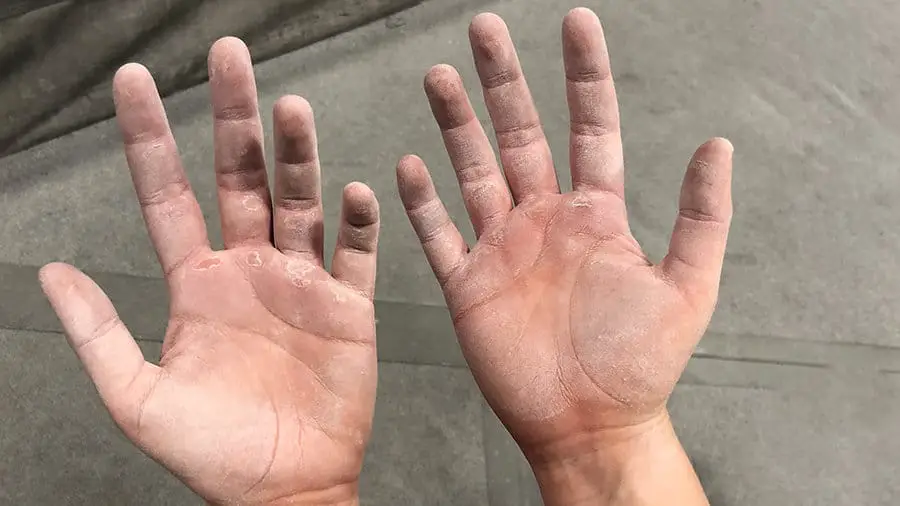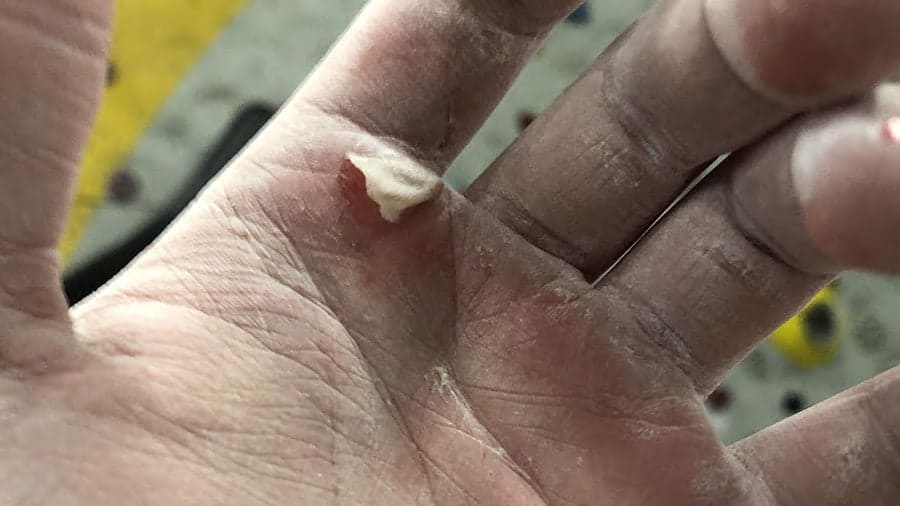When I first started climbing, my hands went through a beating and I would get rock climbing “flappers” almost every week. I thought that flappers were just something I had to deal with if I wanted to continue climbing so I did some research.
The best way to deal with climbing flappers is to prevent them. Of course prevention isn’t always possible so what do you do if you already have one? Basically, the best thing you can do directly after getting one is to clean it with hand soap, place the flap of skin back in place (if possible) and tape it down. You don’t want the tape to stick directly to the flapper, so make sure that you have something between the sticky side of the tape and the flapper.
Now that I’m more experienced and my hands are more conditioned, I don’t get flappers very often but it was more than just time that conditioned my hands, it is also research and asking other climbers what they know. I’ve learned more about preventing and dealing with rock climbing flappers including common causes, how to care for them and what to do to minimize the chances of getting one.
What Is A Rock Climbing Flapper?
A rock-climbing flapper is a piece of skin that is partially torn off of your hand and is only hanging on by an edge. In climbing, this is usually near the top of your palm, below the fingers, or in between knuckles on the inside of your hand. Flappers can vary by size and pain, but they are never enjoyable and can interrupt your climbing session or even other parts of your life, depending on how severe it is.
What Causes A Rock Climbing Flapper?
The most common cause of rock climbing flappers are when climbing callouses become too thick and catch on part of a hold as you are climbing, especially when you are climbing dynamically or doing dynos and your skin tares. It is most common after a long day of climbing and your skin is tired but you decide to do one more climb anyway.
Another cause of rock climbing flappers is from climbing blisters that pop or tare while you are climbing. These are usually less common because they are easily identified before you start a climb and are usually cared for before starting the climb. However, accidental popping or taring occurs.
How Do You Care For A Rock Climbing Flapper?
Caring for rock climbing flappers is less involved than you may think. The nice thing about skin is that it is constantly replacing itself and is incredibly fast at repairs. All you have to do is create an ideal environment for it to create a healthy layer of skin where you tore.
- If at all possible, keep the flapper – don’t clip it off. One thing that will make this easier is by keeping it moist. Keeping it moist will make it so that the skin is pliable and soft. Once it becomes dry, it can become painful against the exposed skin. If you find that it is super stiff and pokes or hurts the exposed skin, then place it under semi-cold water until it becomes soft again. Make sure the water isn’t freezing cold because that may shock your system and you don’t want to interrupt the healing process
- Use climbing tape to keep the piece of skin in place and away from the open-air so it can stay moist. It is ideal not to put the sticky side of the tape directly on the flapper. If you do, when you remove the tape, it will likely get stuck to the skin and tare it off. Either add something soft like pre-wrap or gauze between the tape and flapper or stick some of the tape to itself so that there isn’t a sticky side where the flapper is.
If your flapper is from a climbing blister than it is likely that your skin has already started the healing process and may already be to the point that you can touch the skin underneath without pain or sensitivity. If this is the case, then remove the flapper, don’t tape it back into place
- When your skin heals to the point that you can touch the skin under the flapper without pain, remove the flapper using medical scissors
- While your skin continues to heal, use a climbing balm or climbing salves such as Climbskin or Climb On! or hand cream for climbers to assist with the rest of the healing process.
How Do You Prevent Rock Climbing Flappers?
Ideally, you prevent a rock climbing flapper before it becomes reality and there are a few ways to do that. I’ve learned that the best thing you can do is to pay attention to your hands while you climb. Don’t wait for the pain to look at your hands, check them often. In my research, I also learned a couple of other tricks such as the ones below.

Maintain healthy climbing callouses
It may sound counter-intuitive to maintain climbing callouses when callouses are usually the cause of flappers, but if you are able to maintain them, they can help prevent flappers. The climbing callouses that cause flappers are overgrown callouses that pop outside of the smooth surface of the rest of your skin. To help with the overgrowth, you can use a nail file or even soft sandpaper to level it down to the same size as the rest of the skin on your hand.
If you have been climbing for a while and keep taring the callouses, you may benefit from a rock climbing callus builder. There are products such as antihydral cream that drys your skin and creates a callous like surface on your skin. This product should only be used on the tips of your fingers and sometimes near the top of your palms below your fingers as needed, but don’t put it on your entire hand. As you are using the callus builders, make sure that you keep sanding down any overgrowth so that they don’t get caught on the holds and cause climbing flappers.
Tape your fingers for rock climbing
Taping hands for climbing is a common practice when hands are getting worn or there are signs that a tare may occur. Climbers usually minimize the amount of taping because it affects the sensitivity and grip that you may have on the climbing wall, but if you recognize that a tare/flapper is likely to happen then tape.
Taping the fingers is relatively easy, just make sure that you don’t tape over joints so you can maintain full movement in your fingers. Taping your hands, however, can be difficult because your palm is connected to your fingers and it isn’t a straight area to tape. Depending on what part of your hands needs the tape, you may want to try a few different ways of taping. I’ve found that taping my palm similar to a gymnast who does the high-bar has been helpful for the areas directly under my middle and ring fingers.
Manage how long you climb
When I first started climbing, I could climb for about 30-45 minutes before I started having issues with the skin on my hands. This meant that I could climb for 30-45 minutes without any issues with my hands, but over that amount of time, I noticed that I would at the least get residual sensitivity (I couldn’t use my hands because my skin hurt too much) or I would get flappers and tares shortly after the 45-minute mark.
Once I realized the pattern, I ended my climbing sessions after 45 minutes. This made it so that I could use my hands after a session without additional sensitivity and I was also able to climb more frequently because I didn’t have to care for skin issues such as climbing flappers. Eventually, my hands became more conditioned and I started increasing the time of my climbing sessions while paying special attention to my hands so that I knew when I needed to stop.
As my hands have been conditioned over time, I am now able to climb for over 2 hours before I start having issues (depending on the intensity of the session).
Conclusion
Rock climbing flappers from overgrown callouses or climbing blisters can ruin your climbing session and cause a lot of pain, but there are ways to care for your skin if they happen and prevent them from happening again in the future.
I have found that the best thing for me is to pay attention to my hands while I climb. If I recognize that I have an overgrown callous, I will sand it down right then so that I can keep climbing, but if I have additional sensitivity, I will end the session.
It is better that I build up and condition my hands than it is to do one more climb and risk taring my hand and getting a flapper that affects my climbing for a minimum of a week. In addition, to prevent climbing flappers, maintaining healthy climbing callouses with antihydral cream or other rock climbing callus builders as well as taping fingers and hands for rock climbing.
If you get a climbing flapper, follow the 4 steps outlined above and experiment with using Climbskin, climbing salve, climbing balms or other hand creams for climbers to figure out what works best for you during the healing process.
If you have experience with climbing flappers or recommendations for care or prevention, please share them in the comments below.
More About Safety and First Aid:
- Taping Fingers For Climbing: Why And How
- Proper Nutrition For Tendons For Climbers
- Exercises To Prevent Tendon Injuries For Climbers
- Climbers’ Tendon Injuries And What Causes Them
- 5 Common Injuries In Climbing And How To Prevent Them
- Climbers Guide: First Aid Kit
- How Do You Deal With Climbing Flappers? Prevention And Care
- Should You Wear A Helmet For Bouldering?


